
|   |

|   |
 e-mail: janakipatrik@gmail.com Laying the foundation Photos courtesy: Janaki Patrik January 5, 2020 Life can change in a split second. Mine certainly did. I was studying Russian language and literature, preparing for a career in academia or international politics. But after seeing Birju Maharaj dance in 1963, I made an about-face. At that time he was called "Maharaj-ji" by all. The honorific "Pandit-ji" came later. Yet there was never a question in my mind, that whatever he was called, Maharaj-ji was a charismatic performer and compelling communicator, and I would study Kathak with him. Trained in Western flute and piano for thirteen years starting at age five, I had been entranced by the musicality of a few lines of poetry composed by the 19th century Russian writer Pushkin. The subject was love, of course. Ya vas lyubul... "I loved you and perhaps this love has not yet died..." The sound of the words, the musicality of a language whose verb and noun endings could create unforced rhymes, the still-living tradition of memorizing and reciting poetry as a natural extension of human speech - I loved it all. 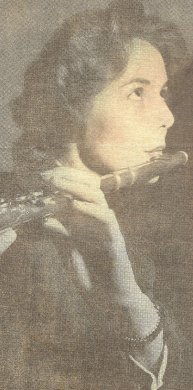 Chicago Daily News -12 Apr 1962 Playing the flute in Morgan Park High School band for Chicago area high school band competition Maharaj-ji's performance also included what had attracted me to the Russian language - the recitation of poetry and rhythmic compositions, the examination of love's facets, the intricate rhythms. I didn't know then - but I heard in my inner ear - that Russian and Hindi are closely related. Their linguistic ancestry shares similar grammatical structures, which create their unique musicality. Pushkin's love poem inspired me to study Russian language and literature in high school and then at Swarthmore College, where I saw Maharaj-ji perform in 1963. He danced stories about the loves of Krishna that attracted me to Kathak. So instead of following the logical path into teaching Russian or working in some aspect of international politics, I went to India. Having written to Kathak Kendra in 1965, I received a reply that I could take an audition with Maharaj-ji, who would then decide whether he would teach me. There was no assurance, just a possibility, but that was enough for me. I prepared for my audition by studying Kathak in New York City from Gina Lalli. She had studied Kathak in Lucknow from Vikram Singh, a student of Maharaj's father Achchan Maharaj. I bought my air ticket and arrived at Palam Airport, Delhi, in the pre-dawn haze of a steamy, monsoon day in July 1967. It never occurred to me that Maharaj-ji would reject me. I was not arrogant. I was simply certain that Kathak was my life path. And it has been just that. 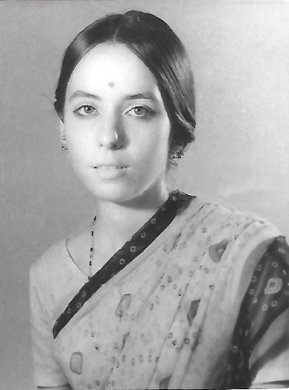 In 1967 at Bal Bhavan / The National Children's School, where Janaki lived with the family of P.P.Garga, Director of the Art Department I am grateful to Dr. Anita R. Ratnam, NARTHAKI's Founder and Managing Editor, for inviting me to write about one aspect of my life in Kathak - my choreography. In a series of columns in Narthaki, I'll deconstruct a few major productions I've created over the past forty years, and I'll tease out some ideas about their choreographic process. But first I'll explain the unlikely path leading me, a young American woman of English, Irish and German heritage, to learn Kathak in India and explore Indian culture by creating dance and music productions. Some of the photos may be hazy and some of my explanations may seem overly analytical. But my life in Kathak took so much "catching up" - learning dance steps, new languages and details of an unfamiliar culture. I lived my dance, not taking time to document my life. BEEJ - The Seed Yes, Maharaj-ji did accept me as his student. Every aspect of my dance training and life in India was integral to my development as a choreographer. I'd go to Kathak Kendra in the morning and stay all day, studying in Maharaj-ji's special Beginners' class alongside Manoranjan Joshi from Kathmandu, Nepal and Nirmala Nandoo from Mauritius. When Maharaj-ji traveled "out of station" to perform, or went to All India Radio for a recording session, one of his senior students taught our class - Pradeep Shankar, Bharati Gupta, Pratap Pawar, Tirath Ajmani - the same material danced differently by each distinctive dancer. Moreover, Maharaj-ji's uncle, Shambhu Maharaj, was still teaching at Kathak Kendra. When he taught fundamental compositions like DHA TA KA THUN GA to his son Kishan Mohan, I noted that even the opening DHA was worlds apart from Maharaj-ji's DHA. This was an eye-opener. From Day One, I observed that "tradition" was fluid, not fixed in stone. Compositions were performed in anything but a carbon-copy manner. 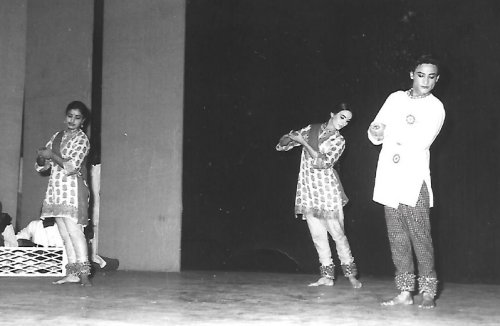 June 1969 - dancing in the Kathak Kendra's Annual Function I watched every class Maharaj-ji taught, every change he made in the choreography of his KRISHNAYANA, every nuance of abhinaya he taught Pradeep Shankar, who played Ghalib in Maharaj-ji's production for the 1969 Ghalib Centennial celebration. The great thumri singer Siddheswari Devi and the powerful pakhawaj Guru Purushottam Das were both teaching at Kathak Kendra then; I studied with both. I attended every performance presented in Delhi by stalwarts including Rani Karnaa, Sitara Devi, Begum Akhtar, Bismillah Khan, Amjad Ali Khan, Nikhil Banerjee and Siddheswari Devi; every presentation in Kathak Kendra's Bindadin Maharaj Mahotsav; heard every item in the all-night Shankar Lal Festival on the Modern School grounds. And I attended every performance Maharaj-ji gave in Delhi. 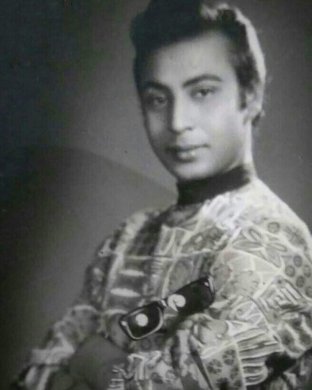 Pradeep Shankar at approximately the time he danced the role of GHALIB (photo courtesy Mahua Shankar)  16 Feb 1969 - Birju Maharaj in the greenroom, after a performance at Sapru House I quickly realized that the "traditional" compositions we learned in the classroom looked very different when Maharaj-ji performed them on stage. The energy of live performance transforms the classroom body into an instrument of concentrated energy - physical and spiritual. Some Kathak dancers even identified performance principles. For example, Bharati Gupta, who had been trained by Shambhu Maharaj and coached by Maharaj-ji in Kathak Kendra's Ballet Unit, epitomized for me natural, intuitive grace - Lucknow adaa and nazaakat. But when I went to her room in the hostel on Sundays to take advantage of her offer to coach me, her lessons included principles of stage craft that were calculated and analytical. "Vilambit compositions should be danced with the eyes liquid and relaxed. Eyes are attentive for Madhyam compositions. The eyes are bright and flashing and wide-open when dancing in Drut laya.... Adjust the distance you throw your gaze according to the size of the venue. For a small venue try to engage your eyes with individual audience members, and then each audience member will think that you are looking only at them. In a huge auditorium don't forget the spectators in the balcony. ...Look way out - don't limit your focus only to the space around your own body. If your gaze is downward, close to your body, it will seem that you are sleeping." 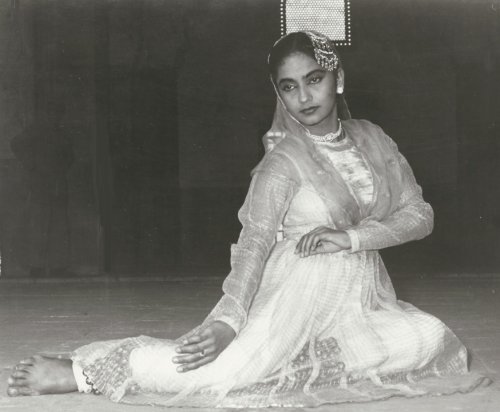 Bharati Gupta A valuable resource for my choreography has been my practice of notating every composition I learned. I never knew if-and-when I would return to India. In the late 1960's emailing, texting, videography, FaceTime, WhatsApp etc. were still decades in the future. International calls were expensive, voices were muffled, the connection might cut abruptly. Consequently, though notating was tedious, arduous work, it was reliable. First I wrote each composition in its rhythmic exactitude - especially analyzing the number of aksharas (beats) included in each pause and in which jati and tala and laya it was composed. I devised a system of rough stick figures to illustrate poses, using arrows to indicate the direction of movement and the pathway of the gaze. For compositions with texts, I wrote the translation of each word and the facial and body movements accompanying every syllable of the text. Bol parhant is of course an invaluable tool. I recited compositions tens of times, until they became a part of my subconscious memory bank and slid off my tongue in precise rhythm. And as I notated more and more compositions, I started to organize them into "families." Below you can see how this results in a greater understanding of the technique. With such understanding and endless recitation of small rhythmic phrases and entire compositions (bol parhant), I could create my own compositions in whatever taal or jati necessary.  During the first years of my training at Kathak Kendra, Maharaj-ji started teaching a morning warm-up class he called "Movement Exercises." All members of the Kathak Kendra 'Ballet Unit', plus the three of us in Maharaj-ji's Beginners' class were expected to attend this class. It was instructive to watch Maharaj-ji's process of codifying the elements of style - the building blocks of the Lucknow Gharana movement vocabulary. He created these exercises before our very eyes, also incorporating his signature sideways tilt of the torso above the waist. Each exercise was done in three different speeds. An increase in speed from vilambit to drut might lead to a transformative "condensation" of the movement. As the speed increased, changes in the direction of focus might also decrease, so that any sense of frenzy was eliminated. Grace was not to be sacrificed at the altar of speed. In his 8 November 2017 interview with Mrinal Shekhar for Friday Magazine, Maharaj-ji made a comment which throws light on his creation of these Movement Exercises. "Once while I was in Russia I came across their ballet schools where young and old alike were putting in years of rigorous training which instils in them a discipline that is evident when they eventually perform. That inspired me. I wanted to see the same poetry in Kathak as well. So I decided to teach Kathak in the same structured manner." I returned home to Chicago in 1969, worn down by the constant harassment by Delhi men whenever I was out in public. Their conception of western women seemed to be based on huge billboards in Connaught Place advertising the latest James Bond movies. Bond was always shown with a voluptuous woman by his side, nothing like my slight frame. My return to the United States initiated the next phase of my dance and choreographic training and the beginning of my performing career. Stay tuned for February 2020's continuation of CHOREOGRAPHING Between Two Worlds! Next instalment: Forming a dance company and diving into choreography - 'BHASHMASHUR, The Ash Demon.' 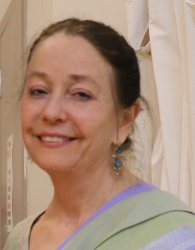 Trained in both classical Kathak dance (Pt. Birju Maharaj, beginning 1967) and Merce Cunningham modern dance technique (1971 to 1978), Janaki Patrik has choreographed thirty full-evening productions and numerous shorter works exploring an eclectic range of poetry, mythic storytelling and music. She is the Artistic Director and Founder (1978) of The Kathak Ensemble & Friends/CARAVAN, NYC. A dedicated teacher, Janaki has trained dancers to perform an extensive repertoire of classical Kathak, as well as her new choreography. Teaching and performing in inner-city schools through Urban Gateways/Chicago and Young Audiences/New York for forty years, Janaki has embodied the power of dance and music to communicate the interconnections of all cultures. Comments * It is really exciting to read Janaki Patrik tell her unique story. She is a scholar and has completely dedicated her life to Kathak as a performer, choreographer and teacher. Wonderful to see her collaborate in Narthaki!! - India en Puerto Rico (Aug 3, 2020) * Wonderful article! Eye-opening & revealing... Janaki Patrik's words are restrained, and yet vibrate with excitement. Introduction to a vast topic requires disciplined sentences, but they also T-h-r-u-m! I, for one,am much looking forward to the next installment. - Unknown (Jan 11, 2020) Post your comments Please provide your name and email id when you use the Anonymous profile in the blog to post a comment. All appropriate comments posted with name & email id in the blog will also be featured in the site. |